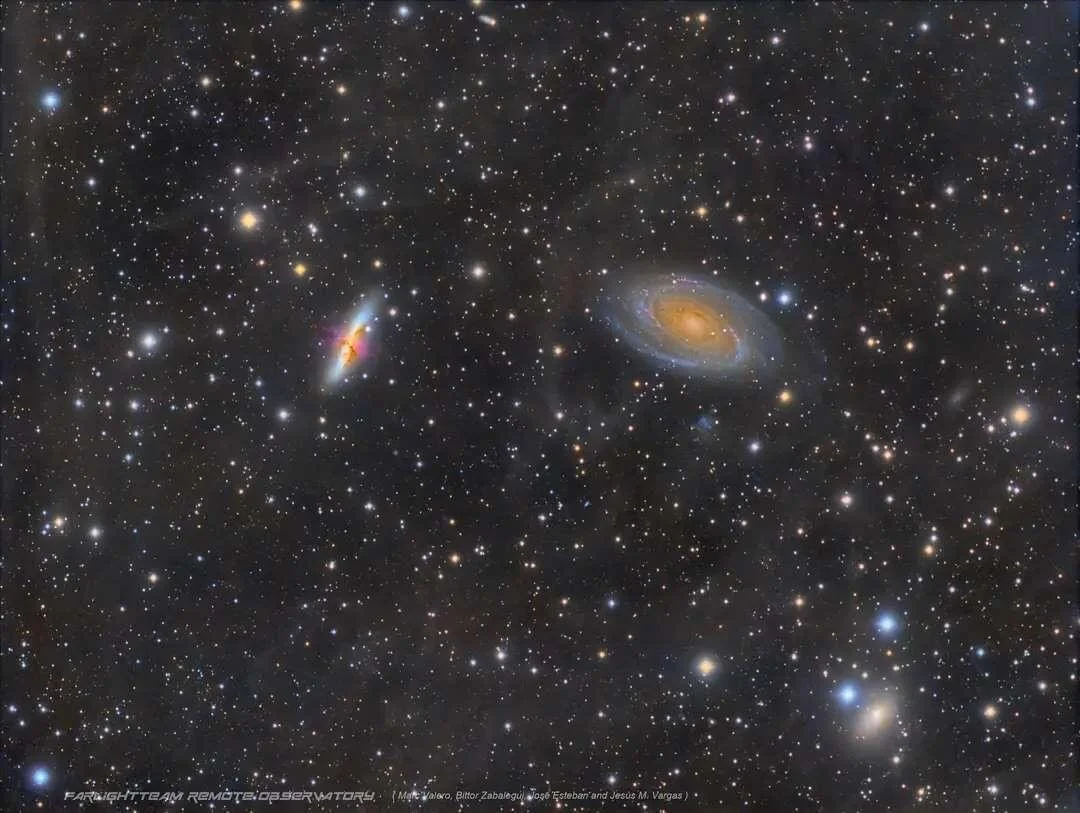
AAPOD2 Image Archives
Bode's Galaxy (M81)
M81, also known as Bode's Galaxy, stands as a beacon of cosmic brilliance in the constellation Ursa Major. Located approximately 12 million light-years away from Earth, this majestic spiral galaxy captivates astronomers and stargazers alike with its striking appearance and intricate structure.
At the heart of M81 lies a bustling hub of stellar activity, where bright, young stars illuminate the surrounding spiral arms with their intense light. These spiral arms, adorned with intricate dust lanes and star-forming regions, spiral outward from the galaxy's central bulge, creating a mesmerizing tapestry of cosmic splendor.
Named after the German astronomer Johann Elert Bode, who first discovered it in 1774, M81 continues to intrigue scientists with its dynamic nature and unique features. Its proximity to Earth and relatively face-on orientation make it an ideal target for detailed observations, offering valuable insights into the processes of galaxy formation and evolution. As astronomers peer deeper into the depths of M81, they uncover the secrets of the universe, unraveling the mysteries of cosmic history and inspiring wonder and awe in all who gaze upon its celestial beauty.
Bode’s Galaxy
Image Description and Details :
Discovered by the German astronomer Johann Elert Bode in 1774, M81 is one of the brightest galaxies in the night sky. It is located 11.6 million light-years from Earth in the constellation Ursa Major and has an apparent magnitude of 6.9.
This Image was captured over two winters with 4 different telescopes spanning from 8" to 12" for a total of 17 hours of exposure using LRGBHa Filters and a monochrome camera.
Copyright: Matthew Proulx
M81, M82, & the Integrated Flux Nebula
Image Description and Details :
Bode's Galaxy, the Cigar Galaxy, and the Integrated Flux Nebula January 6 - January 28 2022 Rowe, NM 305mm Riccardi-Honders @ f/3.8 AP1100 GTO AE Mount, Unguided QHY600PH monochrome @-20*CChroma 50mm x 50mm filtersHaLRGB66.3 hours total integration time
Copyright: Jared Willson
M81 & M82
Well, a first version has already been made with the IFN (Integrated Flux Nebula) processing, clouds of cosmic dust located between the galaxies, specifically this is intergalactic dust that in the background give a somewhat dirty appearance to the image, but they are that, cosmic dust from space, composed of particles smaller than 100 µm.
OBSERVATORY REMOTE FARLIGHTTEAM:
Takahashi FSQ-106 f/5 530mm
CCD QSI 683ws8
Mount 10 Micron 1000
Rotator Pegasus-MGPBox-PowerBox-Armadillo Focuser - Lunatic Zerodew
Voyager software - MountWizar - PixInsight - Adobe PS
Luminance 90 shots of 900 (22`5 hours)
Halfa 56 shots of 900 (14 hours)
Halfa 16 takes of 1200 (5 and a half hours)
RGB 12 shots for each 600 channel (2 hours for each channel in RGB)
Total 48 hours of lights
Darks 60 x900 "+ 60x1200" + 60x600 "
Bias 202
Flats 60xL + 60xHa + 60xR + 60xG + 60xB
Copyright: Jesus Vargas, Marc Valero, Bittor Zabalegui, and José Esteban
M 81 and IFN
Image Description and Details :
Galaxy M 81, located in the Constellation Ursa Major at 12 million AL from the Milky Way. It is a spiral galaxy, relatively modest since its diameter is only 87000 light-years. It is in gravitational interaction with its neighbor M 82.
This picture was taken by Team ARO in South Portugal from 07/03/21 to 12/05/21 in Remote from France.
Equipment used: FSQ 106 on EQ6 Pro mount, ZWO Asi 1600MM camera.
Total exposure time: 25,74H
L=269x2
R=97x2
V=118x2'
B=100x2'
Ha=134x3'
Copyright: Team ARO
A Cosmic Mess - 80 hours of M81 and M82
mage Description and Details :
This 80-hour image shows a deep look into the area of the two galaxies M81 and M82 and surroundings. The well known Integrated Flux Nebula shows a lot of detail Arp's loop is clearly defined. Another very interesting part were the H-Alpha observations. Nothing new, really, but rarely shown in a field this wide. For one the "Cap of M82". Its a small area of glowing hydrogen next to M82, likely associated with the Starburst.The small galaxy Holmberg IX also showed a lot of hydrogen signal, that's why it almost looks purple instead of the "usual" blue.The image was taken from January through April 2021, in 11 different nights. Roughly 2/3 of the data was acquired from a dark site, the rest in my Bortle 6 Backyard. Image details: 80 hours total integration time 21h Luminance 8h Red8h Green8h Blue35h H-AlphaCelestron RASA8 Skywatcher EQ6QHY 183M Processing mainly done in PixInsight, though some in Photoshop
Copyright: Julian Shroff








